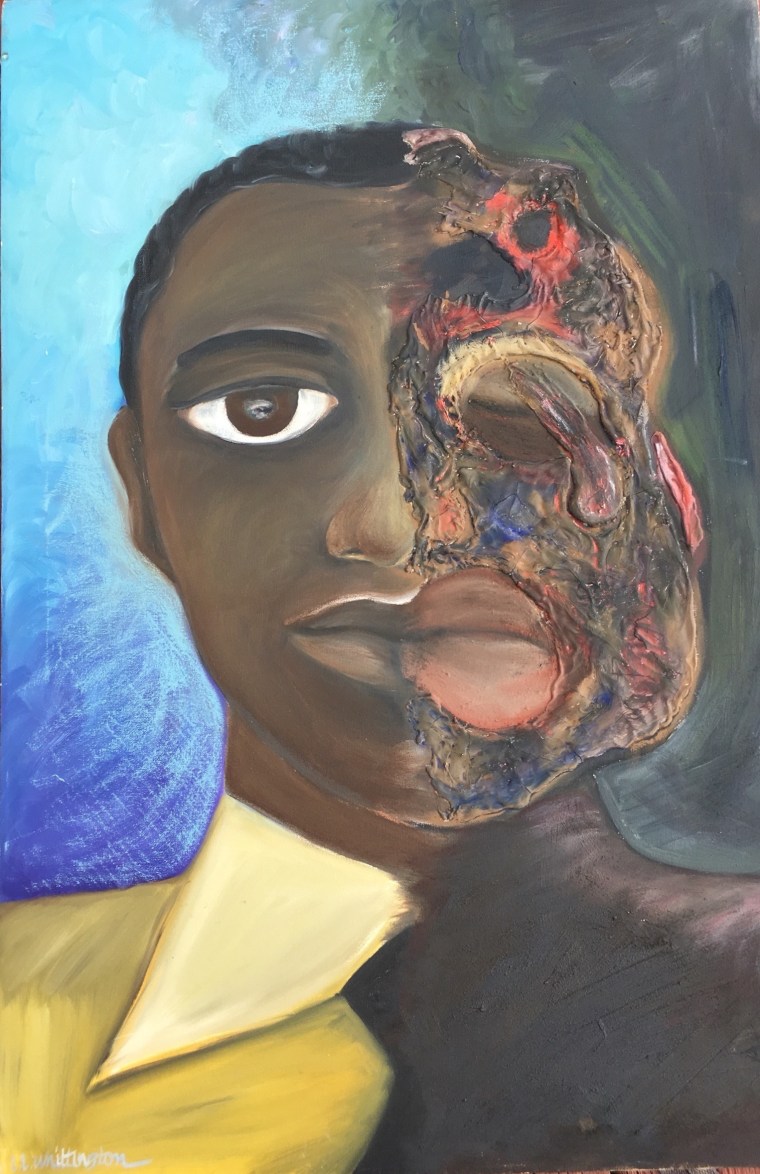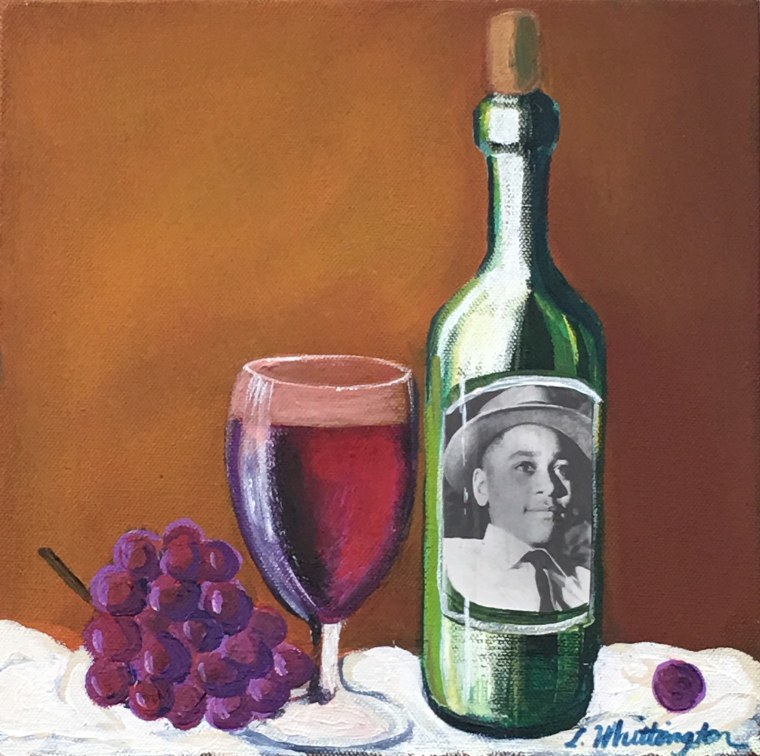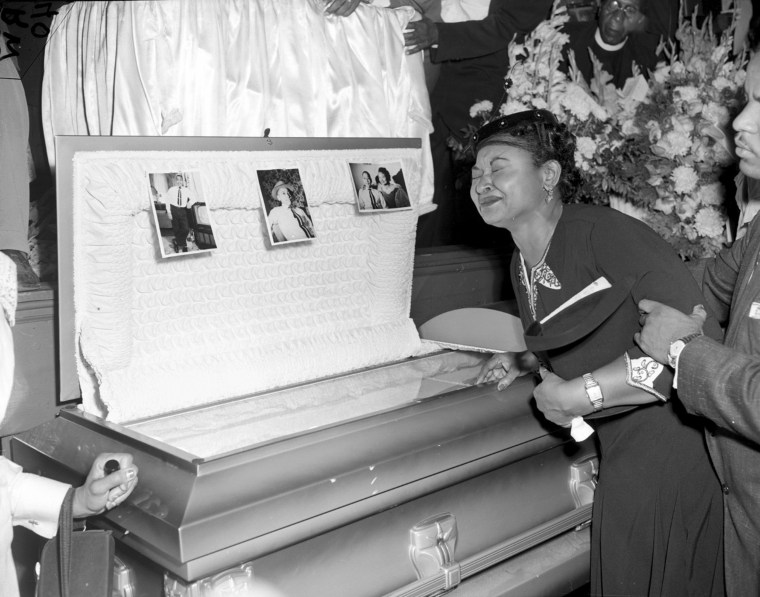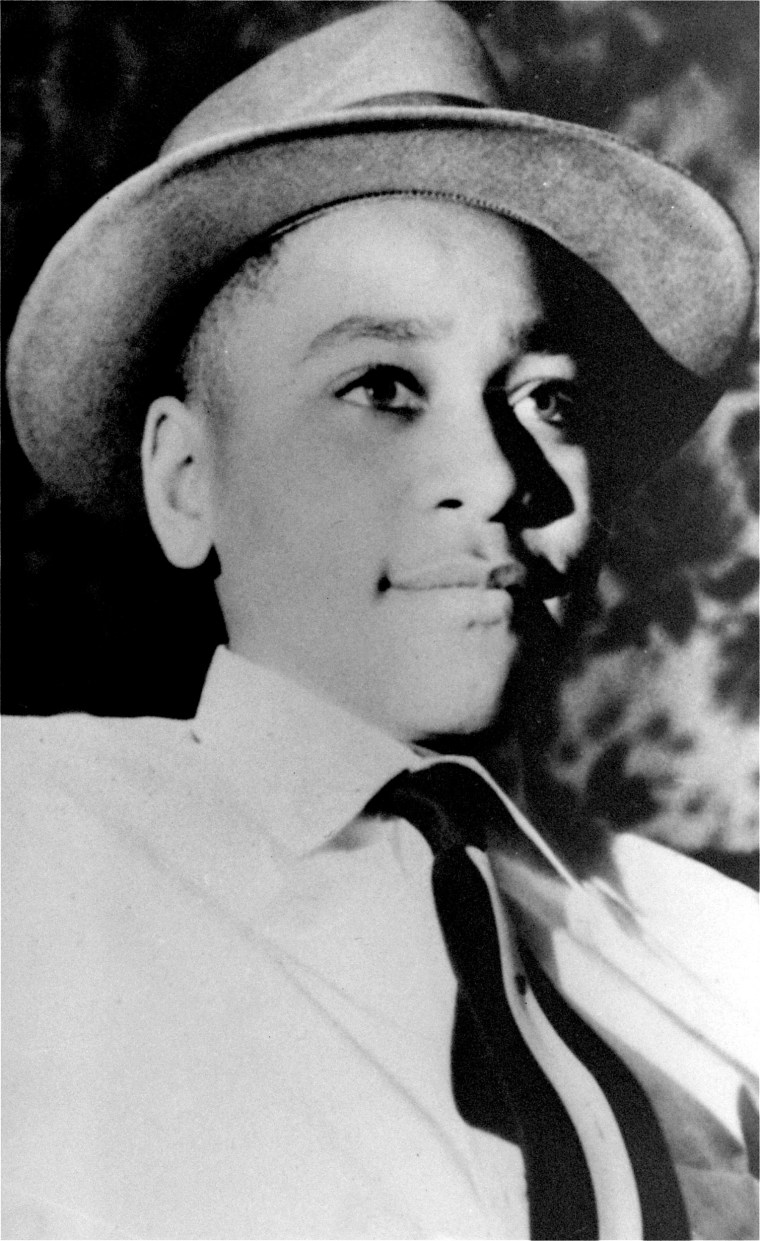NBCBLK caught up with artist, educator, and speaker, Dr. Lisa Whittington to talk about artist intention, her own paintings of Emmett Till, and documenting black pain authentically. Lisa Whittington is a TEDx Deer Park participant who presented the topic, “What Does Art Want With You?”

Can you go through your thought process behind your paintings of Emmett Till and what message you hoped to get across?
I was inspired to create my first painting of Emmett “How She Sent Him and How She Got Him Back” (2012) after I saw a picture of Mamie Till receiving the body of her son at an Illinois terminal after his murder. My painting, commemorate his life and memorializes his death. Mamie Till sent her son to Mississippi a bright cheerful boy, with big beautiful eyes, alive, and in tact. How did she get him back? Tortured, dead, brutalized, naked, shot, eye gouged out, ear missing, unrecognizable.
I remember creating this work and getting angry, feeling emotional, sad, crying, and throwing my paintbrush across the room because it was such an ordeal. I had to imagine pieces of his experience to birth my artwork. Creating the picture was like having to watch him being brutalized and only being able to defend him with my paintbrush. It was frustrating to try to envision this nightmare in your mind and have to translate it to the canvas.
Related: Creator of Emmett Till ‘Open Casket’ at Whitney Responds to Backlash
I thought about Emmett and spoke to him throughout the creation of my work.
What did they do to you Emmett? Why is your ear missing? Where are your clothes? Were you afraid? Were you lonely? Emmett, what did you think about while they were killing you? What did you see in their faces? In their eyes? What did they say to you? Were you already dead when they shot you? Were you numb when they gouged out your eye? Where were your clothes? Why were you naked Emmett? Did they rape you?
I felt sad that he had to experience this. We are supposed to make sure children are protected. Creating the painting is my way of letting him know I cared about his life and what happened to him and that I would not forget him and make sure people remember him as a young bright Black boy, who was kidnapped and died a gory death as punishment for speaking to a white woman. As a teacher, I see Emmett Till in my students every day and worry about their experiences in the world.
I also believed that if Mamie Till had the strength and the stamina to show the world what hatred did to her son, then as an African American, and a responsible artist is my duty to document what they did to her son through my artwork so the world won’t forget.

Stirred by the events of Black Lives Matter, I created the second painting “Libation for Emmett Till” (2016). A libation is an African ritual that pours out a liquid offering in remembrance of those who have passed away, and is still practiced today by African American people who “pour out a little liquor and reminisce.” I reminisce by painting narratives and scenes from my culture and history as an African American.
What do you think of Dana Schutz's painting of Emmett Till at the Whitney Biennial?
Art takes courage. It takes courage to create it, to show it, and to listen to people talk about your work. While I appreciate Dana Shutz’s courage, and attempt to understand — for me, her understanding is not deep enough and careless. The horror was too gentle in her work. She fell short and did not tell a complete story. She downplayed the details and the emotion his death represented.
Looking at her work, it feels like Emmett’s death was easy. Dana dressed him in a tux, put a flower on him, and she allows the viewer to close the casket and move on. When Mamie had an open casket for Emmett, and I watched African American people going up to the casket to view the body of this catalyst and martyr for the Civil Rights Movement, it was not easy.

But from one artist to another, and to be fair to Dana, I researched her. I wanted to know more about her, as an artist, as a person. Her beliefs. Where she stood in society. I looked at her art, and I studied her body of work. I looked for consistency of subject matter to get a sense of her thought process and who she was. And because world events can affect an artist and what we produce, I looked at dates to coincide with what was going on in the world at the time and matched it with her subject matter.
She painted “Open Casket” in 2016, a time when BIack Lives Matter was ripe with protests, and hashtags of Black people being gunned down by White cops were continuously showing up on social media. I can see how Dana could be affected by these world events.
I also read her bio (Saatchi Gallery). Her bio states “My paintings are loosely based on metanarratives.” She also states “I invent imaginable systems and situations to generate information.”
Where is the artwork that interprets the lies that got Emmett Till killed? Where are the portraits of the men who lynched Emmett? What was in their eyes during the act of murder? What color is remorse?
A metanarrative is something that throws off the grand narrative and downplays the truth. I went back to her work and looked again and studied her piece “Open Casket” after learning more about her. And again, I saw a peaceful looking boy laying in a casket with some scars painted in an abstract way. It’s painted well. Consistent with her style. But her painting does not move me. I did not feel the horror of his ordeal. I did not feel the anger of Mamie Till in exposing racism when she declared an open casket. I did not see or feel the same feeling of the photo that was on Jet Magazine.
Dana Shutz created a metanarrative that downplayed what truly happened in history. I asked myself, did she do this all intentionally? This Metanarrative stuff? Or was some of this the way her culture and her race deals with this topic of racism?
As a White woman, did that make her feel better to paint Emmett Till that way? Did it give her solace to downplay the horrible truth of Emmett’s death in a manner in which she can handle it as a white woman and can pass on to other white viewers? Maybe.
I believe she painted Emmett Till in her perspective as a White woman. However it was not deep enough to understand the Black perspective. If her painting, and my painting were side by side, the difference contrast between what a Black woman would see and paint, versus what a White woman would see and paint in the interpretation of Emmett Till’s death/body would be immense.
While Dana Shutz created a work that I feel was casual, the Whitney Museum, its curators, and advisors were irresponsible and have some practices that need to be confronted. Their lack of understanding seep onto the walls of the museum, into the minds of viewers, and into the society. There should have been more guidance and more thought in the direction of the selections chosen for the Whitney Biennial and there would have been African American curators and advisors included instead of an all white and all Asian curatorial staff to ‘speak’ for African Americans.
But I am not convinced that the Whitney is concerned enough to have that guidance from black curators or advisors because the data for artwork from African Americans and women represented in their exhibitions are still at an all time low. The walls are filled with the work of white artists and white men with a few women and even fewer pieces of art from African Americans.
The Whitney Museum played it safe and included the work of a White woman with Black subject matter to be politically inclusive of what is going on in the world amidst all the padding of abstract work that saturate the exhibits.
Historically, Black people and women were considered not “smart enough” to create fine art. But just go to the libraries of historically Black colleges who had to use library space as museum space in order for Black artists to have exhibition space. In addition, Black artists paint more narratives. The White people going to museums don’t want to confront the narratives that Black artists paint. It makes museum patrons uncomfortable.
But Dana Shutz, stylishly wrapped up the narrative of Emmett Till neatly in a coffin with a red carnation to top it off so it was not uncomfortable to look at and I believe the Whitney Museum played it safe and included the work of a White woman with Black subject matter to be politically inclusive of what is going on in the world amidst all the padding of abstract work that saturate the exhibits.
And it’s not just the Whitney, but most museums are stacked with the work of white men, and abstracts at an era in which museums should be doing more social justice and responsible work. Museums still have an elitist, sexist stigma with a racist stench. Especially the Whitney. Statistics show that the Whitney Museum has a track record for the low number of Black artists and women who are selected for their biennial/museum/exhibitions. They are not alone in that that. White women and people of color have very low representation in museums. Having a white woman create a work with Black subject matter, they can pad their statistics.

Statistics show that museums have few representations from people of color and struggle to get Black patrons into the museum. For instance, in 2004, when the Museum of Modern Art opened its new building, and reinstallated it’s permanent collection spanning the years 1880 to 1970, of the 410 works on display only 16 were by women (just 4 percent). Even fewer works were by artists of color. More recently, in April 2015, just 7 percent of the works on display were by women and even fewer by people of color.
If the Whitney was being truly responsible and understanding African American culture, they would have guided Dana to accompany "Open Casket" with more narratives from the Emmett Till story from her point of view as a White Woman and include the white players in the Emmett Till story as part of the narrative.
I want to ask Ms. Shultz, is there nothing that as a white woman that she would want to say? Can you only relate to Mamie? Where is the painting of the woman in the candy store? If she was ashamed or angry at that woman about her behavior, then paint that shame and anger. Where is the painting of the two men in the act of murdering Emmett Till? Imagine if those points of views accompanied the painting? Emmett Till would feel less exploited to those that feel she exploited his dead body.
One of the issues is that Black people don’t see themselves in the museums. Another is that, Black people are not authentically represented.
I would challenge Dana and ask her, are you painting what the elite curators and patrons of the museum don’t want to see? If it is too truthful, are you scared they would not exhibit your work? Where is the artwork that interprets the lies that got Emmett Till killed? Where are the portraits of the men who lynched Emmett? What was in their eyes during the act of murder? What color is remorse? Does she have nothing to say there?
I challenge Dana Shutz to continue the work of "Open Casket," dig deeper and speak the truth. One hundred years from now, when people see “Open Casket” what does she want them to know or to see?
What do you think of the protests?
As a Black person, and as an artist I can understand the protests. People protest when they are frustrated and want to be heard. I truly believe the issues are deeper than just "Open Casket." One of the issues is that Black people don’t see themselves in the museums. Another is that, Black people are not authentically represented.
Not to lessen the point of view of another artist, when museum exhibit sensitive issues such as racism and the ordeal of Emmett Till, there should be authentic representation from people of color in addition to other points of view from other artists. There should be thoughtful statements about the work from the artists and information about the artist that allow people to connect and get to know the artist’s mindset and understand their work.
Do I think it is wrong for White people to paint Black art?
No. I don’t think it is wrong for a white person to paint Black subject matter. Art is a form of communication. Art gets people talking. Art documents mindsets and thought processes. But it has to be done responsibly, especially in this era of time.

Art immerses a person into the work and the culture. To create a work, I have to become the work and relive the experience of the subject matter for it to become alive on canvas. I have to think about what I want to say. Unless Dana Shutz is a monster—like the racists who killed Emmett Till—she gained something from the experience of creating "Open Casket." She is not a monster.
By her creating this painting, we learn that some White people want the racist past to go away. To package it up neatly and paint it pretty and downplay the truth. But racism is not a pretty or an easy topic to talk about let alone to paint a picture about it. It’s just not. But it is necessary because artwork can spark conversations that need to be had.
The question for Dana is, what will you do now? Where do you go from here? People are watching. People are listening. If she says nothing else, then the protestors have a point. But she will have to dig deeper and put away the metanarratives when dealing with black subject matter.
Should the paintings be destroyed?
No no no. Absolutely NOT. Artwork is evidence. Destroying it will erase the evidence. Evidence of appropriation for those that see appropriation. Evidence of bias and racism in modern museums when looking at statistics and presentation and artist representation data. Evidence that the narratives of Black subject matter still make people uncomfortable. Evidence that Black people—and women are still struggling for representation in the Modern museum and turned on each other while White men still take up most of the wall space.
Who has a right to paint the pain and struggle of African Americans?
Anybody who feels compassion, but they must do it responsibly from THEIR perspective and context. However, African Americans have a responsibility to document Black life so the truth is told authentically.
Anything else you would like to add?
I believe the overall problem is more with the gatekeepers than with Dana. Museum society manufactured Dana. If the Whitney or any other contemporary museum (i.e. Museum of Modern Art) were truly concerned about racism and social justice, they would curate an authentic exhibit of Black artists and their point of view.
Remember #OscarsSoWhite? Well #MuseumsSoWhite and #MuseumsSoMale are the equivalent.
Click the links below to see the sad data on women and Black people represented in the museum. The numbers are disturbing. #MuseumsSoWhite and #MuseumsSoMale.
http://www.tronviggroup.com/museums-and-race/
http://www.culturetype.com/2015/05/31/artnews-publishes-special-report-on-women-in-the-art-world
[This interview has been edited for clarity]